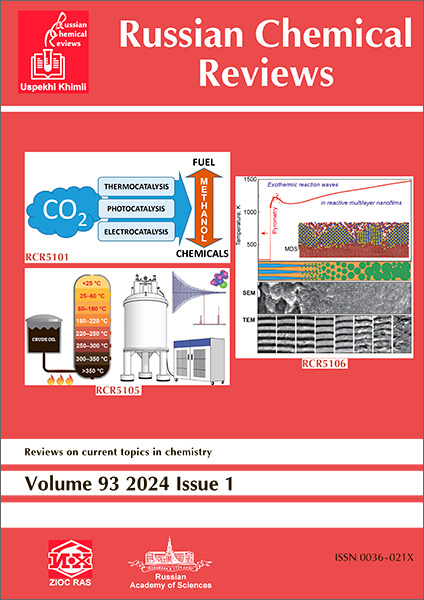有机化合物液相加氢用纳米碳和钯-纳米碳催化剂
IF 6
2区 化学
Q1 CHEMISTRY, MULTIDISCIPLINARY
引用次数: 4
摘要
对钯碳催化剂的合成发展、形成条件的确定和作用机理的阐明等方面的研究成果进行了综合和批判性分析。重点研究了钯/NGC组成(NGC为纳米碳)。考虑了NGC的制备方法,重点是其最常见的形式,炭黑。本文讨论了碳纳米微球及其聚集体的形成机制、纳米微球大小的变化方法、NGC表面功能化使其适合作为钯纳米粒子的载体、钯簇和纳米粒子在碳载体表面的形成机制以及碳纳米微球的结构和表面化学对钯/NGC组合物中钯位状态的影响。在Pd/NGC催化组合物的存在下,有机化合物选择性加氢的已发表的数据进行了整合和系统化。分析了钯/NGC的催化性能,并与其他碳材料(活性炭、碳纳米管)负载的钯催化剂的性能进行了比较。讨论了ngc基钯组合物的制备条件对其在实际重要加氢反应中催化性能的影响。展望了分子设计方法的发展、Pd/NGC组成物的成因研究及其在加氢过程中的应用前景。参考书目包括623篇参考文献。本文章由计算机程序翻译,如有差异,请以英文原文为准。
Nanoglobular carbon and palladium–nanoglobular carbon catalysts for liquid-phase hydrogenation of organic compounds
The results of studies related to the development of synthesis, determination of formation conditions and elucidation of the mechanism of palladium–carbon catalyst action are integrated and critically analyzed. The attention is focused on Pd/NGC compositions (NGC is nanoglobular carbon). Methods for NGC preparation with an emphasis on its most common form, carbon black, are considered. The following issues are addressed: mechanisms of formation of carbon nanoglobules and their aggregates, methods of varying the size of nanoglobules, functionalization of the NGC surface to make it suitable as a support for palladium nanoparticles, views on the formation mechanism of palladium clusters and nanoparticles on the carbon support surface and effect of the structure and surface chemistry of carbon nanoglobules on the state of palladium sites in Pd/NGC compositions. The published data on selective hydrogenation of organic compounds in the presence of Pd/NGC catalytic compositions are integrated and systematized. The catalytic properties of Pd/NGC are analyzed in comparison with the properties of palladium catalysts supported on other carbon materials (activated carbon, carbon nanotubes). The influence of preparation conditions of NGC-based palladium compositions on their catalytic properties in practically important hydrogenation reactions is discussed. Promising trends for further research on the development of molecular design methods, study of the genesis of Pd/NGC compositions and extension of their applications in hydrogenation processes are considered. The bibliography includes 623 references.
求助全文
通过发布文献求助,成功后即可免费获取论文全文。
去求助
来源期刊

Russian Chemical Reviews
化学-化学综合
CiteScore
13.00
自引率
5.20%
发文量
27
审稿时长
6-12 weeks
期刊介绍:
Russian Chemical Reviews serves as a complete translation of the esteemed monthly review journal Uspekhi Khimii, which has been a prominent figure in Russian scientific journals since its establishment in 1932. It offers comprehensive access to the advancements made by chemists from Russia and other former Soviet Union countries.
Established in 1932, Russian Chemical Reviews is committed to publishing timely and significant review articles encompassing various facets of modern chemistry, including chemical physics, physical chemistry, computational and theoretical chemistry, catalysis, coordination chemistry, analytical chemistry, organic, organometallic, and organoelement chemistry, chemistry of macromolecules, applied chemistry, biochemistry, bio-organic chemistry, biomolecular chemistry, medicinal chemistry, materials chemistry, nanochemistry, nanostructures, and environmental chemistry.
 求助内容:
求助内容: 应助结果提醒方式:
应助结果提醒方式:


